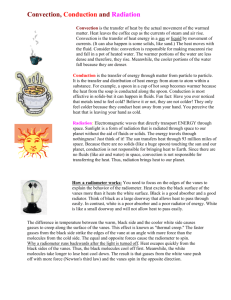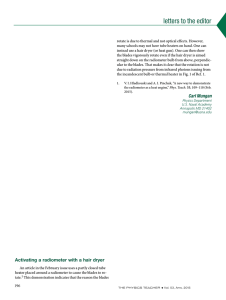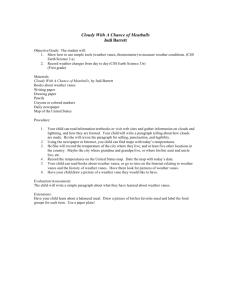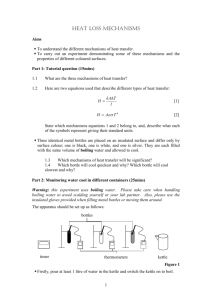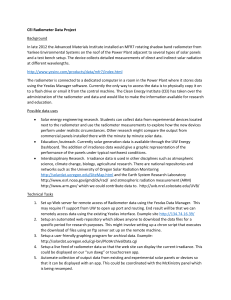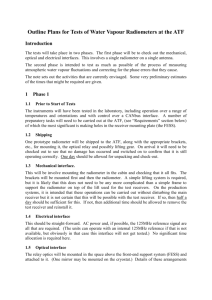Quantifying forces on the Crookes Radiometer Andres Larraza
advertisement
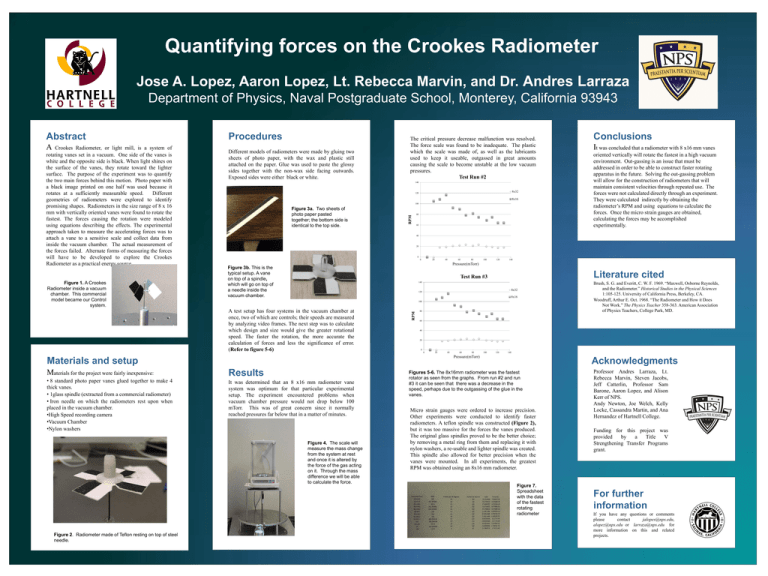
Quantifying forces on the Crookes Radiometer Jose A. Lopez, Aaron Lopez, Lt. Rebecca Marvin, and Dr. Andres Larraza Department of Physics, Naval Postgraduate School, Monterey, California 93943 Crookes Radiometer, or light mill, is a system of rotating vanes set in a vacuum. One side of the vanes is white and the opposite side is black. When light shines on the surface of the vanes, they rotate toward the lighter surface. The purpose of the experiment was to quantify the two main forces behind this motion. Photo paper with a black image printed on one half was used because it rotates at a sufficiently measurable speed. Different geometries of radiometers were explored to identify promising shapes. Radiometers in the size range of 8 x 16 mm with vertically oriented vanes were found to rotate the fastest. The forces causing the rotation were modeled using equations describing the effects. The experimental approach taken to measure the accelerating forces was to attach a vane to a sensitive scale and collect data from inside the vacuum chamber. The actual measurement of the forces failed. Alternate forms of measuring the forces will have to be developed to explore the Crookes Radiometer as a practical energy source. Figure 1. A Crookes Radiometer inside a vacuum chamber. This commercial model became our Control system. Different models of radiometers were made by gluing two sheets of photo paper, with the wax and plastic still attached on the paper. Glue was used to paste the glossy sides together with the non-wax side facing outwards. Exposed sides were either black or white. 140 8x16 100 Figure 3a. Two sheets of photo paper pasted together; the bottom side is identical to the top side. 60 It was concluded that a radiometer with 8 x16 mm vanes oriented vertically will rotate the fastest in a high vacuum environment. Out-gassing is an issue that must be addressed in order to be able to construct faster rotating apparatus in the future. Solving the out-gassing problem will allow for the construction of radiometers that will maintain consistent velocities through repeated use. The forces were not calculated directly through an experiment. They were calculated indirectly by obtaining the radiometer’s RPM and using equations to calculate the forces. Once the micro strain gauges are obtained, calculating the forces may be accomplished experimentally. 20 0 0 20 40 60 80 100 120 140 Pressure(mTorr) Figure 3b. This is the typical setup. A vane on top of a spindle, which will go on top of a needle inside the vacuum chamber. Literature cited Test Run #3 140 8x32 120 8x16 100 80 Results It was determined that an 8 x16 mm radiometer vane system was optimum for that particular experimental setup. The experiment encountered problems when vacuum chamber pressure would not drop below 100 mTorr. This was of great concern since it normally reached pressures far below that in a matter of minutes. Brush, S. G. and Everitt, C. W. F. 1969. “Maxwell, Osborne Reynolds, and the Radiometer.” Historical Studies in the Physical Sciences 1:105-125. University of California Press, Berkeley, CA. Woodruff, Arthur E. Oct. 1968. “The Radiometer and How it Does Not Work.” The Physics Teacher 358-363. American Association of Physics Teachers, College Park, MD. 60 40 20 0 0 20 40 60 80 100 120 140 Pressure(mTorr) Figure 4. The scale will measure the mass change from the system at rest and once it is altered by the force of the gas acting on it. Through the mass difference we will be able to calculate the force. Figure 2. Radiometer made of Teflon resting on top of steel needle. 80 Conclusions 40 Materials and setup • 8 standard photo paper vanes glued together to make 4 thick vanes. • 1glass spindle (extracted from a commercial radiometer) • Iron needle on which the radiometers rest upon when placed in the vacuum chamber. •High Speed recording camera •Vacuum Chamber •Nylon washers 8x32 120 A test setup has four systems in the vacuum chamber at once, two of which are controls; their speeds are measured by analyzing video frames. The next step was to calculate which design and size would give the greater rotational speed. The faster the rotation, the more accurate the calculation of forces and less the significance of error. (Refer to figure 5-6) Materials for the project were fairly inexpensive: The critical pressure decrease malfunction was resolved. The force scale was found to be inadequate. The plastic which the scale was made of, as well as the lubricants used to keep it useable, outgassed in great amounts causing the scale to become unstable at the low vacuum pressures. Test Run #2 RPM A Procedures RPM Abstract Acknowledgments Figures 5-6. The 8x16mm radiometer was the fastest rotator as seen from the graphs. From run #2 and run #3 it can be seen that there was a decrease in the speed, perhaps due to the outgassing of the glue in the vanes. Micro strain gauges were ordered to increase precision. Other experiments were conducted to identify faster radiometers. A teflon spindle was constructed (Figure 2), but it was too massive for the forces the vanes produced. The original glass spindles proved to be the better choice; by removing a metal ring from them and replacing it with nylon washers, a re-usable and lighter spindle was created. This spindle also allowed for better precision when the vanes were mounted. In all experiments, the greatest RPM was obtained using an 8x16 mm radiometer. Figure 7. Spreadsheet with the data of the fastest rotating radiometer Professor Andres Larraza, Lt. Rebecca Marvin, Steven Jacobs, Jeff Catterlin, Professor Sam Barone, Aaron Lopez, and Alison Kerr of NPS. Andy Newton, Joe Welch, Kelly Locke, Cassandra Martin, and Ana Hernandez of Hartnell College. Funding for this project was provided by a Title V Strengthening Transfer Programs grant. For further information If you have any questions or comments please contact jalopes@nps.edu, alopez@nps.edu or larraza@nps.edu for more information on this and related projects.
